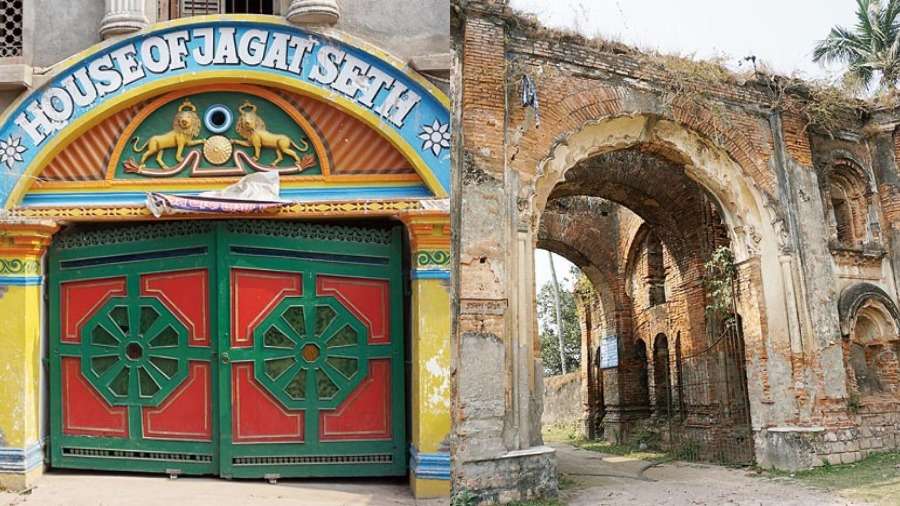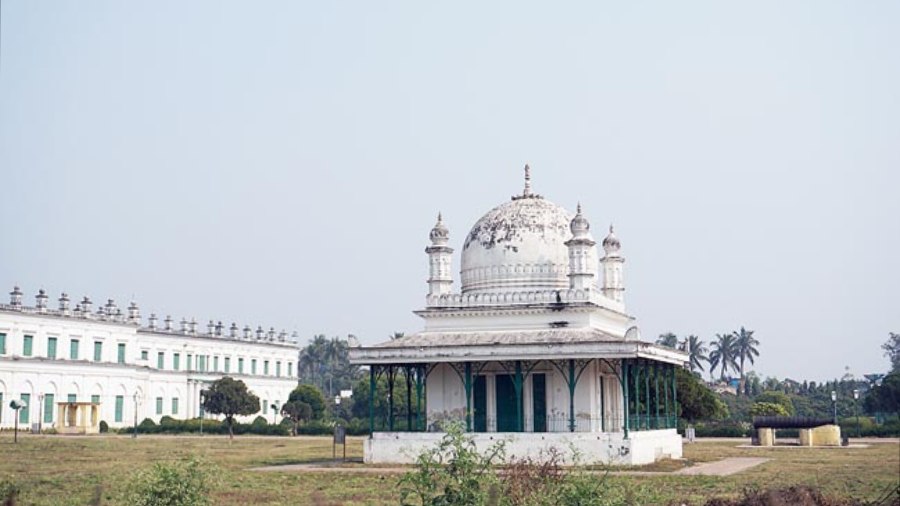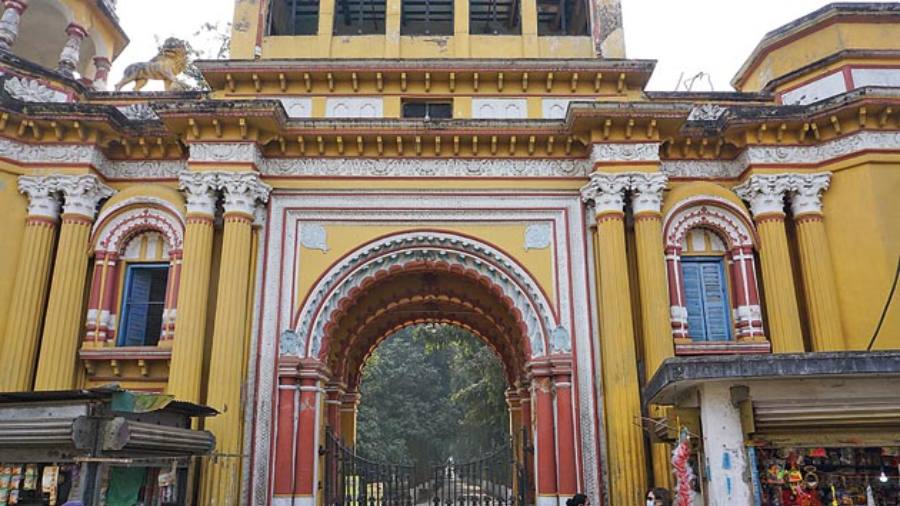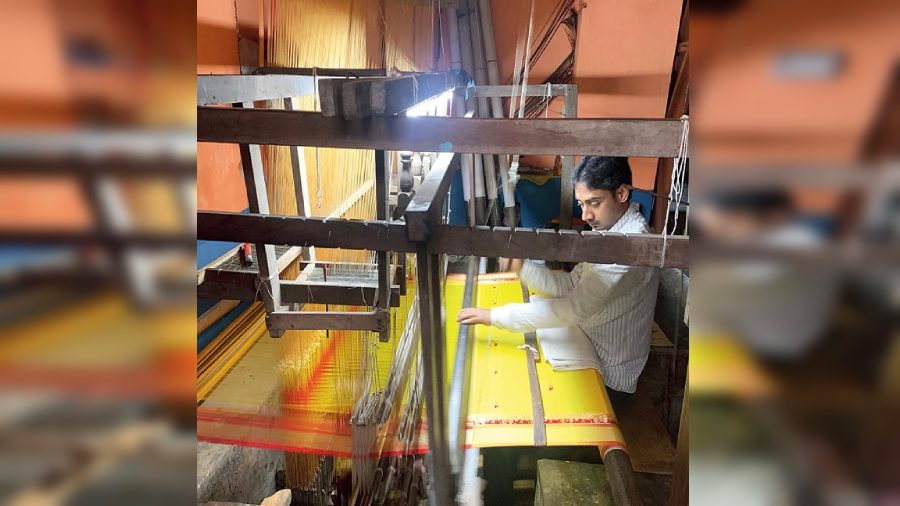When you travel 235km by car on a crisp, sunny winter morning along a national highway, get ferried across the River Bhagirathi on a boat, take a tonga ride through the bylanes of an old Mughal town dotted with mango trees, and hop into a toto, all over one weekend, you are definitely having a blast.
Our trip to Murshidabad was planned with some very close friends keeping Covid restrictions in mind and history as the main attraction. Situated on both banks of the River Bhagirathi, Murshidabad was magical in its quaintness, grandeur and nawabi charm. The city is steeped in history and has some of the country’s grandest architecture dating back centuries.

Picture left: The history of the city as the seat of power is intertwined with that of the financiers of the period, the most well-known of whom was Jagat Seth. Picture Right: With Mir Jafar being infamous for selling out the Nawab of Bengal to the British, it isn’t surprising that his palace is in want of upkeep today.
The town has earned its fame globally not only for its history, but its mangoes and silk and, of course, the Battle of Plassey or Palashi, immortalised in history for the defeat of the last Nawab of Bengal, Siraj-ud-Daulah, who owed his allegiance to the Mughals, by the East India Company that set the ball rolling for the colonisation of India by the British.
I must admit that we Indians, no matter where we belong, are conditioned to plan our meals whenever and however we travel, whatever be the destination. And it gets even better when Bangalis travel in winter. So, armed with copious quantities of food and gorom jama we hit the road at seven in the morning on the last weekend of January.

For readers who would like to make this trip, the best route is Kolkata — Santragachhi — Dankuni — Tribeni — Kalna — Nabadwip — Krishnanagar — Berhampur — Murshidabad. To our delight, we spotted a cute little Cafe Coffee Day tucked away inside an HPCL fuel station on Durgapur Expressway and, even better, it had a clean washroom.
For all you Google Map users, please do not key in Murshidabad as destination at the outset like we did as Google managed to lead us into shortcuts which were hardly worth driving on. Finally, we reached our destination, Jolchhobi resort, around 2pm, pleasantly hungry yet again after polishing off most of the food during two chai breaks.

The Cossimbazar Rajbari (left and right) is an extremely well-maintained place in Murshidabad where one can stay as well. The Rajbhog (below and below left) is a meal served in kansha utensils and lives up to its billing as the ‘food for kings’ quite well
There are a couple of decent places to stay in Murshidabad, but Jolchhobi and Cossimbazar Rajbari of the Roys are not only beautiful but the hospitality deserves special mention. We selected the former as it is located right on the riverbank. It is new, smart, minimalistic and looks very contemporary.
The resort has its own boat, so we took a cruise across the river to experience the most picturesque sunset amidst flights of unknown flocks in the sky. There is something soulful about being in the midst of nowhere. The Bhagirathi is not very wide but extremely deep. The silence consumes you. And the sheer idea of being without a mask was so liberating.
During the Mughal era around the time of Aurangzeb, this town was a seat of trade attracting the Portuguese, the British and the French. It is quite evident why the Mughals shifted the eastern capital from Dhaka to Murshidabad. History unfurled itself in the form of rippled watercolour as we glided over the gentle waves.
Way back in 1717, Aurangzeb made Murshid Quli Khan the governor of Bengal and the town was later named after him. Trade flourished owing to its riverine location and, soon, traders from all over the country as well as the British, the French and the Portuguese started frequenting it and some settled there too.
We will not delve too deep into history, but the family of Jagat Seth, the Singhs from present Uttar Pradesh, and the Dugars settled in Murshidabad. Jagat Seth’s family was the state banker for generations. The nawabs of Bengal were given the right to rule over Bengal, Odisha and Bihar by the Mughal emperor and were backed by financiers like Seth. The development and growth of the town and its majestic architecture is directly connected to flourishing trade and the alluvial soil on which thrived dozens of varieties of mangoes.
Interestingly, the villas at our resort were each named after a type of mango — Golapkhash, Dilkhush, Nawabpasand, Himsagar, Bira, and so on. So my next trip will surely be in summer and dedicated to the nawab of fruits. The day after we reached, the resort arranged for a tonga ride to relish the local flavour. It’s not the most comfortable ride, but post-Covid we felt it was our duty to use the services of local people after the crushing economic slump.
Our first destination was, obviously, the Hazarduari Palace. As the name suggests, the grand, stately piece of architecture, rectangular in shape, boasts of a thousand doors. Only a hundred of these are actual functional doors. The rest were built to misguide the bargis, or Maratha invaders and other miscreants.
Built by Nawab Nazir Humayun Jah, it is a three-storied edifice, very European, with a huge flight of stairs. The Hazarduari shares its premises wih the Nizamat Imambara built by Nawab Siraj-ud-Daulah in 1740, which is another artchitectural wonder. It is supposedly one of the largest imambaras in the world.
The Hazarduari Palace has been converted into a museum, but due to the pandemic visitors are not allowed. The area is dotted with souvenir shops selling beautiful metal (kansha), wood and shola handicrafts.

The gate of the Kathgola Palace is one of quite a few imposing structures adorning the city
Murshidabad is adorned by several other palaces and rajbaris too. I personally found the Kathgola Palace to be the most picturesque. Built by Lakshmipath Singh Dugar, it is a four-storied structure with an impressive ornamental facade that is located in an enormous ‘aam bagan’ or mango orchard.

Nasipur Palace
Our next destinations were Katra Masjid and Nasipur Palace via Jagat Seth’s residence. An absolute contrast to the Hazarduari, the Katra Masjid, built on a sprawling area, displays mammoth Islamic architecture. It houses the tomb of Nawab Murshid Quli Khan. After an hour on the tonga, our fragile backs were as good as gone. So some of us hopped into a Toto (battery-powered small vehicles).
Nasipur is a small village in Lalbagh. Built by Raja Kirti Chandra Singha Bahadur, and later taken over by Raja Debi Singha, the Nasipur Rajbari wears a somewhat forlorn look today. Like many of the settlers who amassed huge wealth owing to their loyalty to the East India Company, Debi Singha, too, hailed from Panipat. Debi Singha was a strict tax collector, one could also call him an extortionist.
I personally found his story — a saga of extortion and debauchery — most fascinating. Debi Singha’s court was illuminated by the famous courtesan Hirabai, who, according to folklore, would be paid 5,000 gold coins for each performance! If any of you have read or watched Tagore’s Khudito Pashan, this palace is a definite reminder of the tragic tale. Unfortunately, the upkeep is rundown but the courtyard, andarmahal and the temples and even the room for beheading tax defaulters inside the palace tell many tales.
Our last destination was the house where Mir Jafar lived. Infamous till date for his betrayal, Mir Jafar was Siraj’s general who, with the help of Jagat Seth, allied with Robert Clive of East India Company and betrayed Siraj to become the first nawab of Bengal who owed allegiance to the British. Till date the family is treated like social outcasts!
Our lunch was pre-booked at the famous Cossimbazar Rajbari of the Roys. Fabulously maintained by the Roy family who have owned it for generations, the pristine white building is a perfect amalgam of the west and east. Run at present by Pallab Roy, a descendent of the family, the emerald green lawns are embellished by a riot of seasonal blooms.
It is a regal retreat with plush living quarters and ornate furniture which will make you feel like royalty. The family crest is carved most fashionably above the pediment over the main gate. The ‘royal lunch’ or ‘rajbhog’ served at the Rajbari should not be missed. It is a seven-course sinfully opulent spread.
We were lucky to be given a tour of the palace by Pallab Roy himself. Tucked away inside the Rajbari is a boutique with beautiful souvenirs , handicrafts like shola, Krishnanagar dolls, kanshaware (bronze) and hand-painted silks.

The weavers of the taantipara make fabulous Murshidabad silks, but many have to keep at their craft in rather impoverished circumstances
The last leg and another very interesting adventure awaited us — a trip to the taanti para, or weavers’ neighbourhood. Our Toto driver served as our guide. This is a cluster of villages consisting of families who have been weaving some of the most beautiful Murshidabad silks.
There are rows of homes of different scales, some with one loom, some with more. Unfortunately, these talented artisans have to keep at their craft under rather impoverished circumstances. They were most hospitable to tourists like us indulging in retail therapy. We feasted our eyes on some fabulous gheecha, tussore and Murshidabad silks, some of them hand-painted.
That night, when we sat on our balcony wondering at the quiet river that fostered the old town and was witness to so much, I remembered the old lullaby: Khoka ghumolo para jurolo borgi elo deshey, Bulbulitey dhaan kheyechhe, khajna debo kishey?
Pictures by the author
The author is a PR professional turned social entrepreneur






